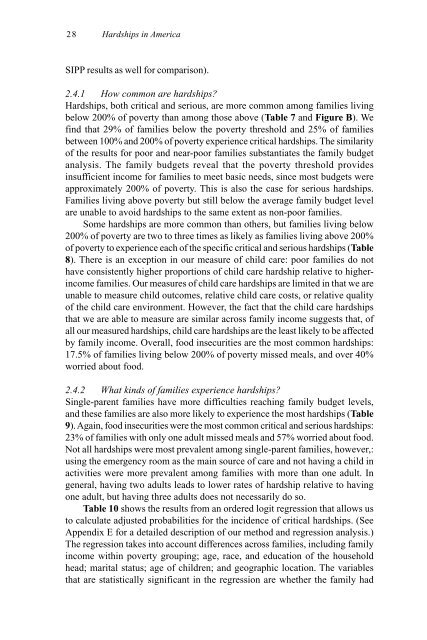Create successful ePaper yourself
Turn your PDF publications into a flip-book with our unique Google optimized e-Paper software.
28 Hardships in America<br />
SIPP results <strong>as</strong> well for comparison).<br />
2.4.1 How common are hardships<br />
Hardships, both critical and serious, are more common among families living<br />
below 200% of poverty than among those above (Table 7 and Figure B). We<br />
find that 29% of families below the poverty threshold and 25% of families<br />
between 100% and 200% of poverty experience critical hardships. The similarity<br />
of the results for poor and near-poor families substantiates the family budget<br />
analysis. The family budgets reveal that the poverty threshold provides<br />
insufficient income for families to meet b<strong>as</strong>ic needs, since most budgets were<br />
approximately 200% of poverty. This is also the c<strong>as</strong>e for serious hardships.<br />
Families living above poverty but still below the average family budget level<br />
are unable to avoid hardships to the same extent <strong>as</strong> non-poor families.<br />
Some hardships are more common than others, but families living below<br />
200% of poverty are two to three times <strong>as</strong> likely <strong>as</strong> families living above 200%<br />
of poverty to experience each of the specific critical and serious hardships (Table<br />
8). There is an exception in our me<strong>as</strong>ure of child care: poor families do not<br />
have consistently higher proportions of child care hardship relative to higherincome<br />
families. Our me<strong>as</strong>ures of child care hardships are limited in that we are<br />
unable to me<strong>as</strong>ure child outcomes, relative child care costs, or relative quality<br />
of the child care environment. However, the fact that the child care hardships<br />
that we are able to me<strong>as</strong>ure are similar across family income suggests that, of<br />
all our me<strong>as</strong>ured hardships, child care hardships are the le<strong>as</strong>t likely to be affected<br />
by family income. Overall, food insecurities are the most common hardships:<br />
17.5% of families living below 200% of poverty missed meals, and over 40%<br />
worried about food.<br />
2.4.2 What kinds of families experience hardships<br />
Single-parent families have more difficulties reaching family budget levels,<br />
and these families are also more likely to experience the most hardships (Table<br />
9). Again, food insecurities were the most common critical and serious hardships:<br />
23% of families with only one adult missed meals and 57% worried about food.<br />
Not all hardships were most prevalent among single-parent families, however,:<br />
using the emergency room <strong>as</strong> the main source of care and not having a child in<br />
activities were more prevalent among families with more than one adult. In<br />
general, having two adults leads to lower rates of hardship relative to having<br />
one adult, but having three adults does not necessarily do so.<br />
Table 10 shows the results from an ordered logit regression that allows us<br />
to calculate adjusted probabilities for the incidence of critical hardships. (See<br />
Appendix E for a detailed description of our method and regression analysis.)<br />
The regression takes into account differences across families, including family<br />
income within poverty grouping; age, race, and education of the household<br />
head; marital status; age of children; and geographic location. The variables<br />
that are statistically significant in the regression are whether the family had



